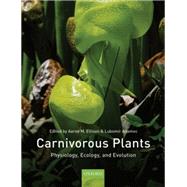- ISBN: 9780198779841 | 0198779844
- Cover: Hardcover
- Copyright: 2/21/2018
Aaron Ellison, Senior Research Fellow, Harvard University, Harvard Forest, Massachusetts, USA,Lubomir Adamec, Senior Research Scientist, Institute of Botany of the Czech Academy of Sciences, Czech Republic
Aaron M. Ellison (http://harvardforest.fas.harvard.edu/aaron-ellison) is the Senior Research Fellow in Ecology at Harvard University, and a semi-professional photographer and writer. He studies the disintegration and reassembly of ecosystems following natural and anthropogenic disturbances; thinks about the relationship between the Dao and the intermediate disturbance hypothesis and reflects on the critical and reactionary stance of Ecology relative to Modernism.
Lubomir Adamec is the Senior Research Scientist in the Section of Plant Ecology of the Institute of Botany CAS at Trebon, Czech Republic, where he has been working since 1986. Since graduating in plant physiology from the Charles University in Prague, Czechoslovakia, he has been studying the ecophysiology of aquatic and wetland plants, especially carnivorous ones: mineral nutrition, photosynthesis, growth traits, Utricularia trap ecophysiology, and biophysics. He is the curator of the world's largest collection of aquatic carnivorous plants, currently including more than 80 species or populations, which is used extensively for research and plant conservation.
Part I: Overview
1. Introduction, Aaron M. Ellison and Lubomir Adamec
2. Biogeography and habitats of carnivorous plants, J. Stephen Brewer and Jan Schlauer
3. Evolution of carnivory in angiosperms, Andreas Fleischmann, Jan Schlauer, Stephen A. Smith, and Thomas J. Givnish
Part II: Systematics and evolution of carnivorous plants
4. Systematics and evolution of Droseraceae, Andreas Fleischmann, Adam T. Cross, Robert Gibson, Paulo M. Gonella, and Kingsley W. Dixon
5. Systematics and evolution of Nepenthes, Charles Clarke, Jan Schlauer, Jonathan Moran, and Alastair Robinson
6. Systematics and evolution of Lentibulariaceae: I. Pinguicula, Andreas Fleischmann and Aymeric Roccia
7. Systematics and evolution of Lentibulariaceae: II. Genlisea, Andreas Fleischmann
8. Systematics and evolution of Lentibulariaceae: III. Utricularia, Richard W. Jobson, Paulo C. Baleeiro, and Castor Guisande
9. Systematics and evolution of Sarraceniaceae, Robert F.C. Naczi
10. Systematics and evolution of small genera of carnivorous plants, Adam T. Cross, Maria Paniw, Andre Vito Scatigna, Nick Kalfas, Bruce Anderson, Thomas J. Givnish, and Andreas Fleischmann
11. Carnivorous plant genomes, Tanya Renner, Tianying Lan, Kimberly M. Farr, Enrique Ibarra-Laclette, Luis Herrera- Esrella, Stephan C. Schuster, Mitsuyasu Hasebe, Kenji Fukushima, and Victor A. Albert
Part III: Physiology, form, and function
12. Attraction of prey, John D. Horner, Bartosz J. Plachno, Ulrike Bauer, and Bruno Di Giusto
13. Functional anatomy of carnivorous traps, Bartosz J. Plachno and Lyudmila E. Muravnik
14. Motile traps, Simon Poppinga, Ulrike Bauer, Thomas Speck, and Alexander G. Volkov
15. Non-motile traps, Ulrike Bauer, Reinhard Jetter, and Simon Poppinga
16. Biochemistry of prey digestion and nutrient absorption, Ildiko Matu%sikova, Andrej Pavlovic, and Tanya Renner
17. Mineral nutrition of terrestrial carnivorous plants, Lubomir Adamec and Andrej Pavlovic
18. Why are plants carnivorous? Cost/benefit analysis, whole-plant growth, and the context- specific advantages of botanical carnivory, Thomas J. Givnish, K. William Sparks, Steven J. Hunter, and Andrej Pavlovic
19. Ecophysiology of aquatic carnivorous plants, Lubomir Adamec
20. Biotechnology with carnivorous plants, Laurent Legendre and Douglas W. Darnowski
Part IV: Ecology
21. Prey selection and specialization by carnivorous plants, Douglas W. Darnowski, Ulrike Bauer, Marcos Mendez, John D. Horner, and Bartosz J. Plachno
22. Reproductive biology and prey-pollinator conflicts, Adam T. Cross, Arthur R. Davis, Andreas Fleischmann, John D. Horner, Andreas Jurgens, David J. Merritt, Gillian L. Murza, and Shane R. Turner
23. Commensals of Nepenthes pitchers, Leonora S. Bittleston
24. Pitcher-plant communities as model systems for addressing fundamental questions in ecology and evolution, Thomas E. Miller, William E. Bradshaw, and Christina M. Holzapfel
25. The Utricularia-associated microbiome: composition, function, and ecology, Dagmara Sirova, Jiri Barta, Jakub Borovec, and Jaroslav Vrba
26. Nutritional mutualisms of Nepenthes and Roridula, Jonathan A. Moran, Bruce Anderson, Lijin Chin, Melinda Greenwood, and Charles Clarke
Part V: The future of carnivorous plants
27. Conservation of carnivorous plants, Charles Clarke, Adam Ross, and Barry Rice
28. Estimating the exposure of carnivorous plants to rapid climatic change, Matthew C. Fitzpatrick and Aaron M. Ellison
29. The future of research with carnivorous plants, Aaron M. Ellison and Lubomir Adamec
The New copy of this book will include any supplemental materials advertised. Please check the title of the book to determine if it should include any access cards, study guides, lab manuals, CDs, etc.
The Used, Rental and eBook copies of this book are not guaranteed to include any supplemental materials. Typically, only the book itself is included. This is true even if the title states it includes any access cards, study guides, lab manuals, CDs, etc.
Digital License
You are licensing a digital product for a set duration. Durations are set forth in the product description, with "Lifetime" typically meaning five (5) years of online access and permanent download to a supported device. All licenses are non-transferable.
More details can be found here.






